A Morning Moon Lets Us Admire Leftover Meteors and Andromeda’s Jewels, and Peruse Evening Planets!
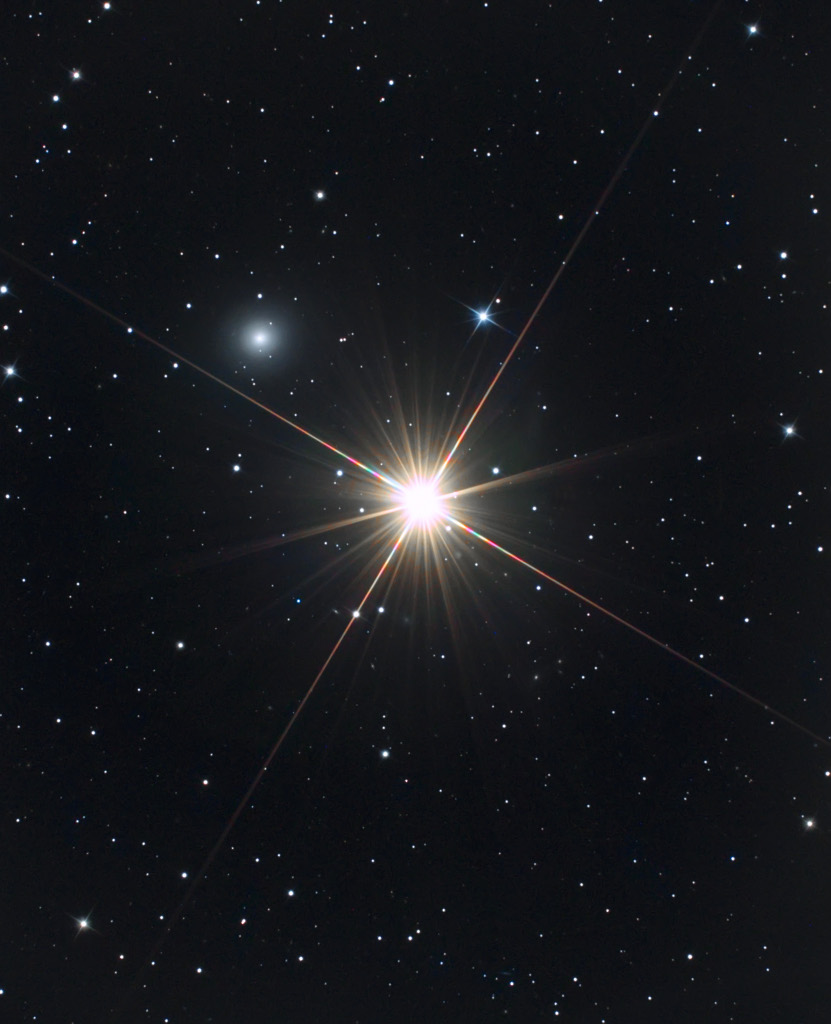
This image by Kent Wood was NASA’s Astronomy Picture of the Day for October 27, 2017. It shows the bright star Mirach aka Beta Andromedae and the distant background elliptical galaxy NGC 404 positioned just to its north-northwest (upper left of centre). The galaxy, which is nick-named Mirach’s Ghost, can be seen in 6″ or larger aperture telescopes on dark nights, but the nearby star adds to the challenge.
Hello, My Stargazing Friends!
Here are your Astronomy Skylights for the week of November 20th, 2022 by Chris Vaughan. Feel free to pass this along to your friends and send me your comments, questions, and suggested topics. You can also follow me on Twitter as @astrogeoguy! Unless otherwise noted, all times are expressed in Eastern Time. To subscribe to these emails please click this MailChimp link.
If you’d like me to bring my Digital Starlab portable inflatable planetarium to your school or other daytime or evening event, or deliver a session online, contact me through AstroGeo.ca, and we’ll tour the Universe, or the Earth’s interior, together! My terrific book with John A. Read entitled 110 Things to See With a Telescope is a guide to viewing the deep sky objects in the Messier List – for both beginners and seasoned astronomers. DM me to order a signed copy!
The moon will spend this week approaching and then passing the sun at new moon. While it is missing from evening skies, we can watch for off-peak meteors from several showers and admire the delights of Andromeda. All of the planets except Mercury and Venus can be appreciated in evening skies. Read on for your Skylights!
More Meteors
Meteor season continues! Meteors from the recent Northern Taurids and Southern Taurids meteor showers will continue to appear, some as colorful fireballs, streaking away from Taurus while they taper off during this week. In fact, around 3:27 am Eastern Standard Time on Saturday morning, November 19, many people in the Golden Horseshoe region around Toronto / Hamilton saw and reported an extremely bright fireball meteor (or bolide) traversing the sky for several seconds! Check your video doorbell and look for videos on social media! (I shared a couple on Twitter.) You can review the map of reports at the website of the International Meteor Organization here. Analyses indicates that the fireball was travelling northeast across the Niagara region.
The Leonids Meteor Shower, which is derived from bits of material dropped when periodic Comet 55P/Tempel-Tuttle will also continue until December 2. It peaked on Thursday evening in the Americas. Many Leonids have persistent trains and strong colour. True Leonids travel in a direction away from a radiant among the stars that form the head of Leo (the Lion).
The terrific Geminids meteor shower has just begun. That shower, which can deliver up to 150 meteors per hour, will peak on the night of December 13-14. But a very bright moon will spoil the show a bit this year.
The Moon
The moon will be missing from the evening sky worldwide until its slim crescent returns to shine briefly after sunset on the coming weekend. Until then, stargazers can take advantage of the darker overnight skies and see the autumn star clusters, nebulae, and galaxies at their best. Astronomers call those targets Deep Sky Objects, or DSOs.
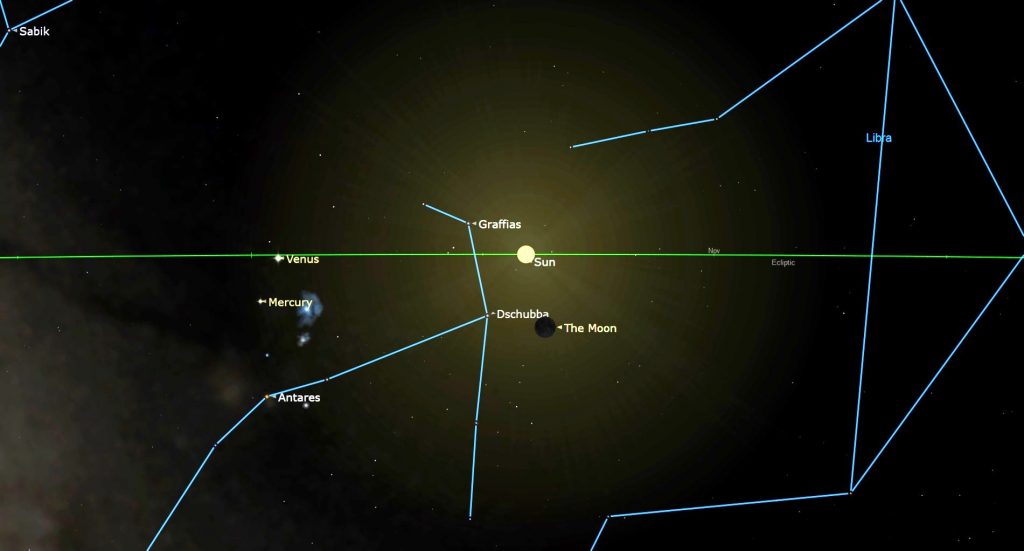
If you are someone who misses the moon, you can catch sight of it by heading outside before sunrise. On Monday morning between about 4 am local time and dawn, the pretty, slim crescent of our natural satellite will be shining in the southeastern sky near the bright, white star Spica in Virgo (the Maiden). Watch for the very bright, orange-tinted star Arcturus to their Upper left (or celestial north).
On Tuesday, the even older moon will drop below Virgo and into Libra (the Scales) – but the surrounding sky will be too bright to see any stars around it. That will be our last glimpse of the moon until Friday afternoon. In the meantime, the moon will reach its new phase on Wednesday, November 23 at 5:57 pm EST, 2:57 pm PST, or 22:57 Greenwich Mean Time. At that time our natural satellite will be located in Scorpius, just 2.3 degrees south of the sun. While new, the moon is travelling between Earth and the sun. Since sunlight can only reach the far side of the moon, and the moon is in the same region of the sky as the sun, the moon becomes unobservable from anywhere on Earth for about a day (except during a solar eclipse). Everyone on Earth sees the same phase of the moon – but it might not be above your horizon when a particular phase occurs because the moon’s phases are independent of Earth’s rotation.

Friday’s moon will show as a 5%-illuminated arc. Its two tips will point towards the stars of Sagittarius (the Archer) – but those stars won’t appear until the moon is setting. On Saturday evening, the moon will show a thicker crescent. Its increased angle from the sun will carry east – it to the handle of Sagittarius’ teapot-shaped asterism – allowing it to set in a darker sky. Observers from Florida south to northern South America can watch the moon pass in front of, or occult, the bright stars Tau Sagittarii, or Namalsadirah II after 5:30 pm EST. Other places will see the moon merely skim closely past that star. You can view lunar occultations in binoculars and any size of telescope.
On next Sunday evening, the moon will start a trip through Capricornus (the Sea-Goat), the current home to Saturn.
The Planets
Although Mercury and Venus will be hugging the southwestern horizon immediately after sunset, but only observers in the tropics will be able to spot them safely once the sun has completely disappeared. If you can find bright Venus’ dot on Thursday, watch for the faint arc of the young crescent moon positioned almost a palm’s width to its left (or celestial southeast). The two inner planets will become easier to see next week.

Once the sky has completely darkened, around 6 pm local time at mid-northern latitudes, all the rest of the main planets will be above the horizon. Mars, Jupiter, and Saturn will form a 120 degrees long arc across the sky – tracing out the plane of our solar system. Saturn, the most westerly planet, will set around 10 pm – but Mars will take all night to cross the sky. Around 8:10 pm local time tonight (Sunday), Mars, ascending in the east, and Saturn, descending in the southwest, will both be about 21 degrees above the horizon. Jupiter will shine above and between them (though closer to Saturn). Uranus, Neptune, and a couple of major asteroids will lurk between the bright planets.
Yellow-tinted Saturn will become visible in the southern sky by about 5:45 pm local time. Enjoy your views of it as soon as you can find it in your telescope because it will look less crisp as it drops lower after mid-evening. Saturn will be shining just to the right (celestial west) of the medium-bright tail stars of Capricornus (the Sea-Goat), Deneb Algedi on the left (celestial east) and Nashira on the right (celestial west). In the coming months, you’ll be able to use binoculars or your sharp eyesight to see that Saturn’s easterly prograde motion is shifting the planet toward them. I plotted Saturn’s long-term path here.
On a night with steady air, good binoculars in the range 10×42, 10×50, or larger should present Saturn and its rings as a tiny oval. On those nights, even a small telescope can show Saturn’s subtly banded globe encircled by its glorious rings, which are sufficiently edge-on to Earth to allow Saturn’s southern polar region to extend well below the ring plane. (Your telescope might flip the planet.) See if you can make out the Cassini Division, a narrow, dark gap that separates Saturn’s main inner ring (named B) from its bright outer ring (named A). Any telescope should show that a segment of Saturn’s rings adjacent to the eastern limb of the planet is in shadow.
A small telescope can also pick up several of Saturn’s moons – especially its largest, brightest moon, Titan! From here on Earth, Saturn’s axial tilt of 26.7° lets us see the top of its ring plane, and allows its brighter moons to array themselves all around the planet. Because Jupiter’s axis is only tilted by 3°, Jupiter’s moons are arranged in a line running through Jupiter’s equator .
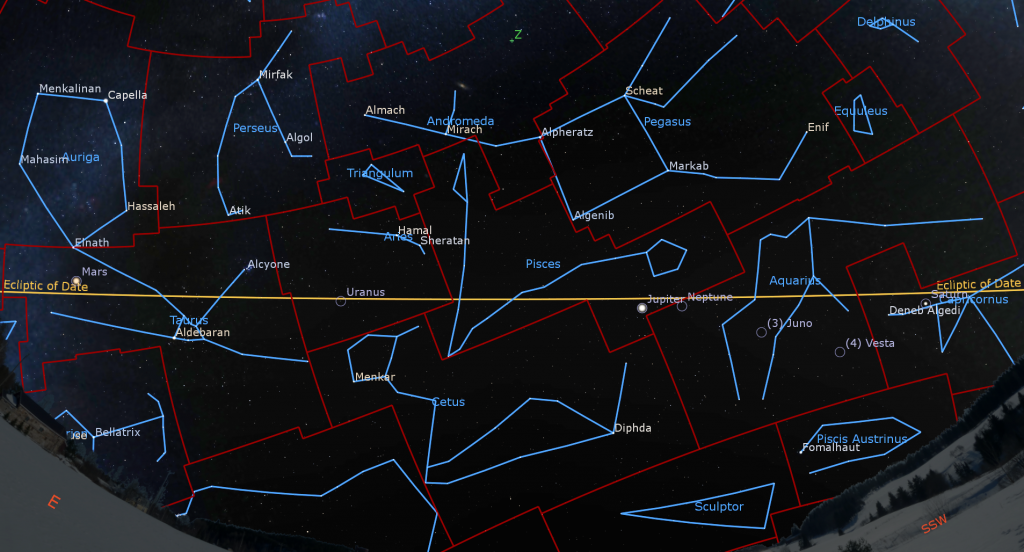
Titan never wanders more than five times the width of Saturn’s rings from the planet. The much fainter moon named Iapetus can stray up to twelve times the rings’ width during its 80-day orbit of Saturn. The next brightest moons Rhea, Dione, Tethys, Enceladus, and Mimas all stay within one ring-width of Saturn. During evening this week, Titan will migrate counter-clockwise around Saturn, moving from the right (or celestial west) of Saturn tonight (Sunday) to the left (or celestial east) of Saturn next Sunday. (Remember that your telescope might flip that view around.) How many of the moons can you see in your telescope?
The extremely bright, magnitude -2.7 planet Jupiter will become visible in the southeast shortly after 5 pm local time. Nothing else will be close to matching its brilliance until half as bright Mars appears. Jupiter will look best in a telescope when it climbs highest (or culminates) due south around 8 pm local time, and then it will set in the west at about 2 am local time. On Thursday, Jupiter will pause its motion through the background stars of western Pisces, marking the end of a westward retrograde loop that began in late July. After that night it will start to accelerate eastward, eventually closing its gap with Mars.
Your binoculars will show Jupiter as a small disk flanked by its string of four Galilean moons named Io, Europa, Ganymede, and Callisto. They complete orbits of the planet every 1.7, 3.6, 7.2, and 16.7 days, respectively. If you see fewer than four moons, then one or more of them is crossing in front of or behind Jupiter, or lurking in Jupiter’s dark shadow – or two of the moons are very close together or occulting one another. Their arrangement varies each night.
Use your binoculars to spy a pentagon-shaped ring of low-brightness stars shining about a fist’s diameter above Jupiter. They make up the western head of Pisces (the Fishes). Above those stars, the Great Square of Pegasus (the Flying Horse) will be visible, even with your unaided eyes. It’s located about 2.5 fist diameters above Jupiter. (I wrote about Pegasus last week.)
Even a small, but decent quality telescope can show you Jupiter’s dark belts and light bands, which are aligned parallel to its equator. With a better grade of optics, Jupiter’s Great Red Spot, a cyclonic storm that has raged for hundreds of years, becomes visible for several hours when it crosses the planet every 2nd or 3rd night. For observers in the Americas, that GRS will cross Jupiter’s disk in early evening on Sunday, Wednesday, and Friday, late on Tuesday, Thursday, and Sunday evening, and after midnight on Friday and next Sunday. If you have any coloured filters or nebula filters for your telescope, try enhancing the GRS with them.
The round, black shadows of Jupiter’s Galilean moons are visible through a good backyard telescope when they cross the planet’s disk. For observers in the America’s, Io’s shadow will cross Jupiter’s equator on Thursday night between 7:48 pm and 9:55 pm EST. On Wednesday evening, observers in western North America can watch the small shadow of Europa cross the southern hemisphere of the planet from 10:20 pm to 12:40 am PST. Don’t forget to adjust these quoted times into your own time zone.
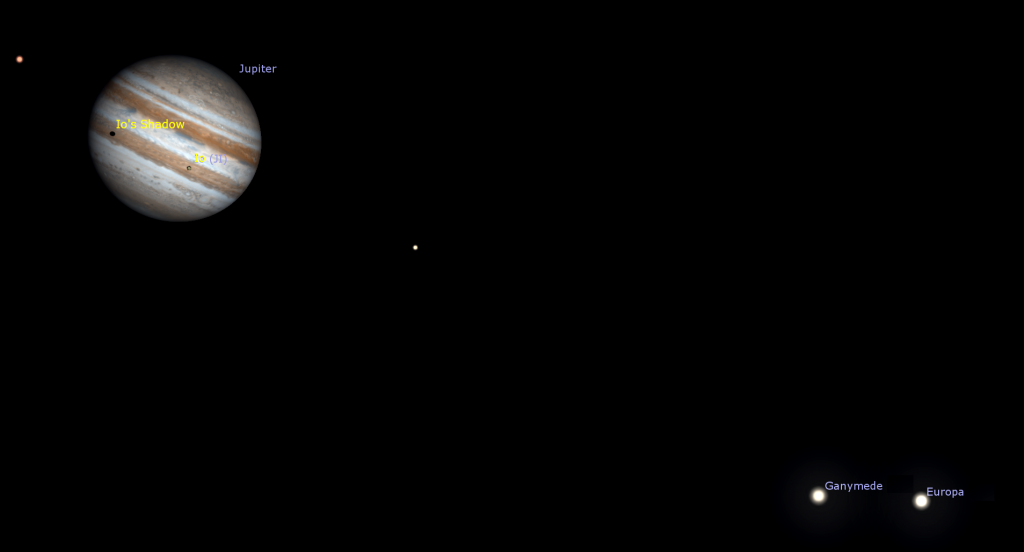
Magnitude 7.9 Neptune is located a palm’s width to the right (or 6° to the celestial west-southwest) of Jupiter, which will slide a wee bit closer to the distant planet every night. Neptune’s apparent disk size is 2.3 arc-seconds (20 times smaller than Jupiter’s). Try to view Neptune while it is highest, around 8 pm. Neptune is binoculars-close to several groups of medium-bright stars. I posted a finder chart for Neptune here. The large asteroids designated (4) Vesta and (3) Juno are currently in Aquarius (the Water-Bearer) between Jupiter and Saturn, too.
As I mentioned above, the noticeably red-tinted planet Mars will rise at 6 pm and then clear the northeastern treetops at about 7 pm local time. Over the next 10 days, Mars will grow in apparent size (in your telescope’s eyepiece) and increase its visual brightness in the sky (currently at magnitude -1.66) – all because Earth is passing the red planet on the inside track. The two planets’ minimum separation, which happens every 25.5 months, will occur around midnight Eastern Time on November 30. This week, we’re 83 million km, or 4.6 light-minutes away, and closing.

Mars is a terrific object to view in a backyard telescope when it gets this close. This week, Mars will climb highest, and sit due south, around 1:30 am local time – but views during late evening will be nearly as good. In a telescope this week, Mars will show a waxing, 99%-illuminated disk. If the air is steady you might see some dark markings wrapping around the planet and the white patch of its northern polar cap. Mars takes about 20 minutes longer than Earth to rotate once fully on its axis. So viewing the planet at the same local time on subsequent nights will show roughly the same view of it with surface markings shifted by about 5°. If you have coloured filters for your telescope, see if the blue, orange, or red one improves the view.
Due to Earth’s faster motion, Mars is experiencing a westerly retrograde loop that will last through its December 7 opposition and into mid-January. This week, Mars will continue to be positioned between the two horn tip stars of the bull, medium-bright Zeta Tauri (the lower star) and Elnath or Beta Tauri (the higher star). Over the next month, you can watch Mars steadily slide west towards the bright Pleiades star cluster.
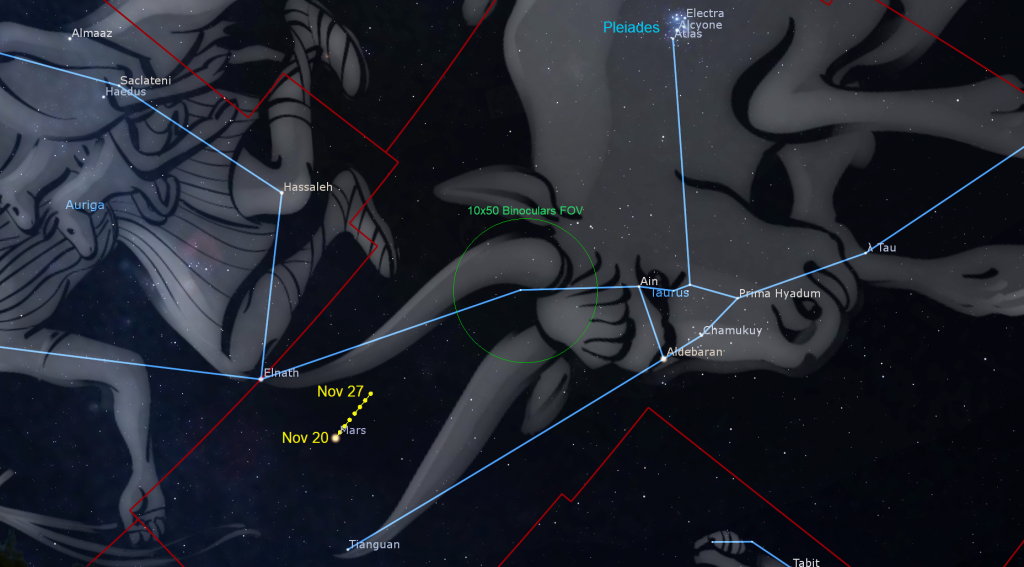
The distant blue-green planet Uranus is located about midway between Mars and Jupiter, and about 1.4 fist widths to the upper right (or 14° to the celestial west-southwest) of the Pleiades star cluster. Closer guideposts to Uranus are several medium-bright stars, including Botein (or Delta Arietis), Al Butain II (or Rho Arietis), and Sigma Arietis, which will appear several finger widths from the planet. Those stars mark the feet of the Aries (the Ram). Magnitude 5.6 Uranus will be high enough for telescope-viewing, in the lower part of the eastern sky, by 7 pm local time this week. It will climb to its highest point in the southern sky around 11 pm local time.
Admiring Andromeda
During the fall, I like to showcase the constellations involved in the Greek mythological story of Perseus and Andromeda. If you missed last week’s detailed look at Pegasus, I posted it with pictures here. This week, I’ll tell you more about the princess herself. We’ll tour the other constellations in her story in future posts. In the meantime, once upon a time…
Andromeda was the beautiful daughter of Queen Cassiopeia and King Cepheus of Ancient Ethiopia. Through no fault of her own, the princess became the centre of a great tale from Greek mythology. After her mother angered the Nerieds (Sea Nymphs) by boasting of Andromeda’s unrivaled beauty, the god of the sea Poseidon (aka Neptune) sent Cetus, the Sea-monster to ravage Ethiopia’s coast. An oracle told King Cepheus that his only solution was to sacrifice Andromeda to Cetus. So she was chained to rocks by the sea-shore. Just as Cetus was about to take Andromeda, the hero Perseus happened to be flying by on his winged sandals. She must have been beautiful indeed, because he instantly fell in love with her, slew the beast, and cut her free from her chains. One drop of the beast’s blood mixed with the sea foam, and Pegasus the flying horse was born. After more adventures, including one where Perseus accidently killed his evil grandfather to fulfill a prophecy, the couple sailed to Argonis, where they raised a family of many children. The mighty Hercules, a summer constellation, is descended from them.
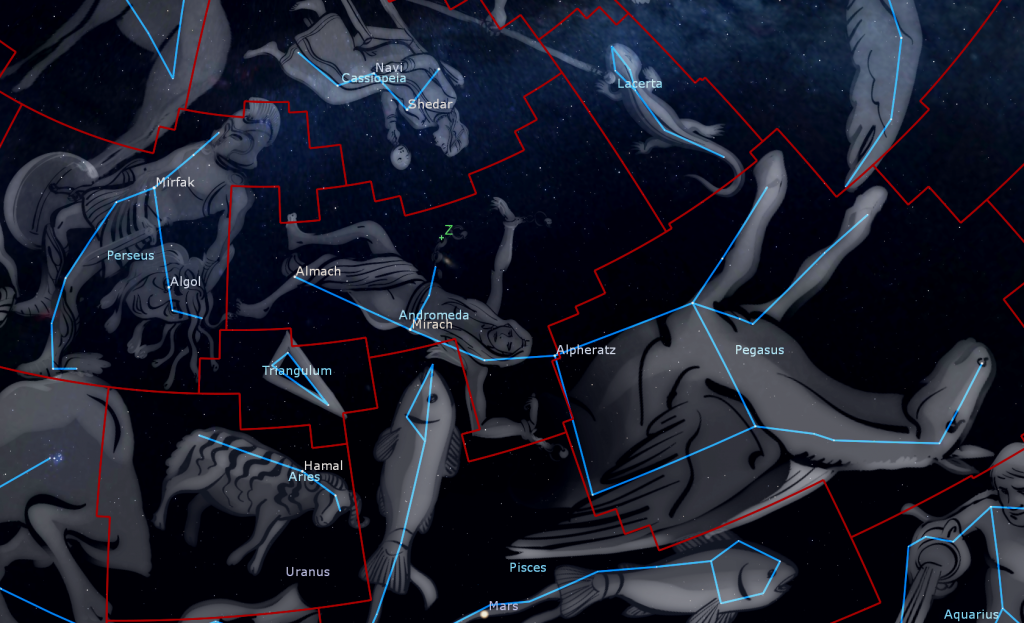
Andromeda is one of the original classical constellations, and is 19th largest by area (out of 88). Also known as the Chained Lady, she is depicted as laying prone with her body and legs extending to the east (left) – the latter formed by two chains of stars that diverge towards her feet. A row of dimmer stars that extends upwards toward the Milky Way represents her chains. Like Pegasus, Andromeda’s location north of the celestial equator means that her stars are visible from everywhere on Earth except Antarctica. A number of ancient cultures saw a woman’s figure in those stars. The ancient Chinese also envisaged legs – but used a different arrangement of stars. You can view a nice portrait of her here. (Parental discretion is advised.) The Navajo saw her stars as a great desert lizard.
A large part of Andromeda’s territory occupies the sky above (north of) Pegasus and below (south of) Cassiopeia. While modern star charts don’t draw lines between any of the medium-bright stars in that part of the sky, classical depictions of the princess assign those stars to the rocky crag she’s chained to.
Andromeda is visible throughout the fall and winter, but in early December she is high in the southern sky, almost directly overhead, during mid-evening. She is connected to Pegasus on her western (right) side. Her brightest star, named Alpheratz “the Horse’s Shoulder”, marks her head, and is also serves as “third base” of Pegasus’ Great Square. Pisces (the Fishes) swim below her, while Triangulum (the Triangle) is just to the left (east) under her feet. Andromeda’s mother Cassiopeia is above her, and Perseus lies off to her left (east). He’s under her feet, but positioned to her upper left in the sky.
Let’s tour the best parts of Andromeda, starting at her head, which is marked by bright Alpheratz (or Alpha Andromedae). It’s a hot, blue-white supergiant star located only 97 light-years away from us. The spectrum of this star’s light indicates that it is highly enriched in the metal mercury. To see the rest of the princess, look for two slightly curved horizontal lines of three modest stars each that extend to the northeast (left) from Alpheratz. The lower stars are brighter than the upper set. They diverge as you move away from her head, the way her gown would spread out towards her feet.
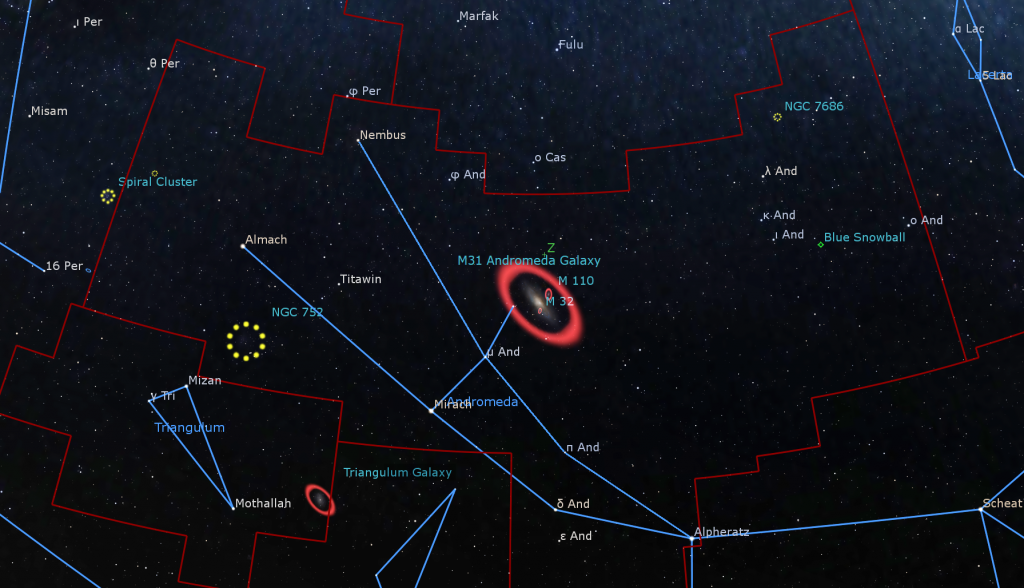
Tracing the lower line of three stars from Alpheratz, reddish Delta Andromedae (or δ And) sits roughly a palm’s width left (east) of Alpheratz, marking the princess’ lower shoulder. The next star, another palm width farther, is a bright reddish star called Mirach. This is a cool, red giant star located 200 light-years from Earth. It produces 1,900 times more light than our sun! Mirach happens to have a 10 million light-years-distant elliptical galaxy tucked in close above it called Mirach’s Ghost (or NGC 404) – but you’ll need a large telescope to see its fuzzy little patch. (Keep Mirach in mind – we’ll return to it later.)
Continuing left by a fist’s diameter, we reach one of Andromeda’s feet – the bright double star named Almach “desert lynx”. Almach’s beautiful golden and sapphire stars easily are seen in a small telescope. The two stars differ in both brightness and colour.
About midway between Mirach and Almach, and a thumb’s width above the line connecting them, sits a medium-bright magnitude 4.1 star named Titawin (or Upsilon Andromedae). The main star is a binary system with a faint, orbiting companion. Four Jupiter-sized exoplanets discovered between 1996 and 2010 orbit that star! Three of the planets have been named after Andalusian scientists: Saffar, Samh, and Majriti. The magnitude 3.55 star that marks Andromeda’s higher foot is an orange-tinted star named Nembus.
Andromeda’s higher should is marked by a modest star named Pi Andromedae that shines several finger widths above Delta Andromedae.
Now, head back to Mirach and follow Andromeda’s waist / chain upwards. Sitting about four finger widths above Mirach is a dimmer white star designated Mu Andromedae (or μ And). (It’s actually the centre star of Andromeda’s higher leg.) A few finger widths above that star sits another even dimmer star named Nu Andromedae (or v And). Look just above that one for a large fuzzy patch. That’s Messier 31 (or M31, for short), better known as the Andromeda Galaxy – one of the sky’s best sights! This massive twin to our Milky Way galaxy spans six full moon diameters across the sky. It has a bright core and dim oval halo that is oriented east-west (left-right). It’s easy to see with binoculars. Using a good sized telescope at low magnification, more treasures are revealed – including two smaller elliptical galaxies sitting just above and below the main galaxy. The smaller of the two, named M32, is positioned nearer to M31’s centre. It is closer to us than the big galaxy. The other, named M110, is farther – in the background.
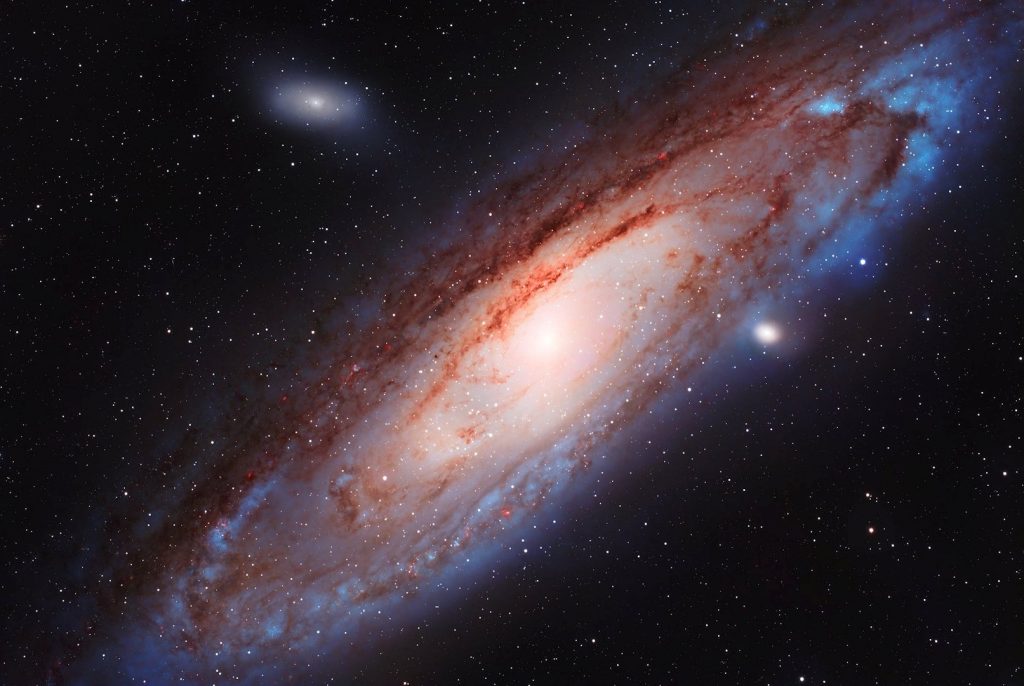
Under dark skies, you should be able to glimpse the Andromeda Galaxy using unaided eyes only. At about 2.5 million light years away, it’s one of the farthest objects visible to unaided human eyes! We’re going to collide with it in about 5 billion years, but that’s another story!
Andromeda contains two more interesting deep sky objects. A large, loose open star cluster named NGC 752 is located below and between Almach and Mirach. Look for a tight little triangle of warm-tinted stars in its core and a bright pair of close-together stars at its edge. On the opposite end of the constellation, about 1.5 fist diameters above Alpheratz is the Blue Snowball (or NGC 7662). This magnitude 8.3 planetary nebula, the decaying corpse of a star of similar mass to our own sun, is fairly easy to see in backyard telescopes – but it’s tiny. In your telescope, look for a non-twinkling dot with a faint blue-green colour.
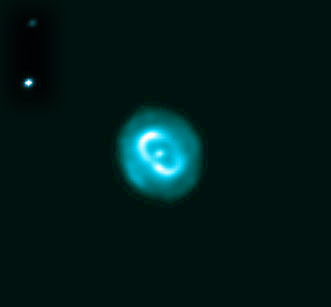
Public Astro-Themed Events
Every Monday evening, York University’s Allan I. Carswell Observatory runs an online star party – broadcasting views from four telescopes/cameras, answering viewer questions, and taking requests! Details are here. They host in-person viewing on the first clear Wednesday night each month. On Wednesdays they stream views online via the observatory YouTube channel. Details are here.
My free, family-friendly Insider’s Guide to the Galaxy webcast with Samantha Jewett of RASC National returns on Tuesday, November 22 at 3:30 pm EST. This time, we’ll focus on the upcoming Mars opposition, the Herschel’s and how they established the various catalogues we use today to list deep sky objects (nebulae, galaxies, and clusters), and we’ll launch our tour through RASC’s Finest NGC objects observing program. You can find more details and the schedule of future sessions here.
On Friday evening, November 25 at 7:30 pm EDT, the RASC Mississauga Centre will live stream their monthly Speaker Night meeting. This month will feature ME! My talk will be Adventures in Moongazing: Making the Most of Moonlit Nights. I’ll highlight some of the best things to see on the moon and my favorite moon books and resources. Everyone is invited to join the meeting on Zoom. Details are here.
Keep looking up, and enjoy the sky when you do. I love questions and requests. Send me some!